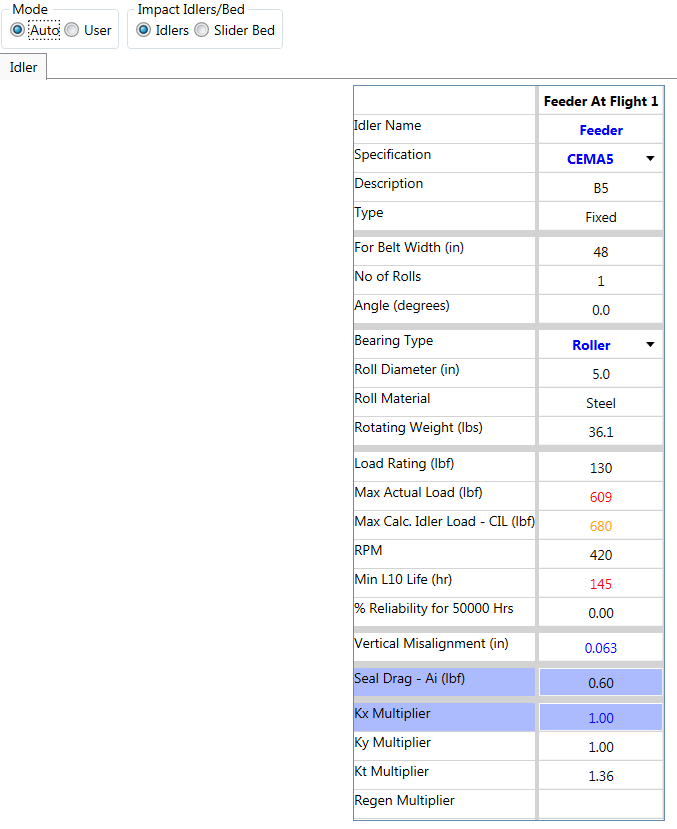|
<< Click to Display Table of Contents >> Idler Tab Details |
  
|
|
<< Click to Display Table of Contents >> Idler Tab Details |
  
|
This tab is used to input the selection details for the idlers or slider bed.
Only flat idlers can be used in the feeder section at this time.
Auto DB, User DB or Custom mode is selected at the top.
•When the Auto DB mode is selected, the software chooses the idler Description from the database selected in the Specification box. The idler selection procedure follows the guidelines based on bearing life that are detailed in the CEMA manual.
•In the User DB mode, the software user can select the idler Description from a list of applicable idlers from the database selected in the Specification box.
•In the Custom mode, the user can/must input all the idler data without any reference to a database.

Everything in blue is editable. Everything that is red indicates an out-of-spec condition. Everything in yellow indicates a condition that should be reviewed by the user.
•Specification is name of the database from which the idler is chosen.
When using a database, the idler description and specification must be from one of the available databases; nevertheless, much of the data can be edited on this input screen. Idler descriptions can be added to the databases or edited.
•The Description of the idler comes from the idler database and cannot be modified on this screen.
•The idler Type is either "Fixed" or "Garland". If it is specified in the database, it cannot be changed on this screen. If it is not specified in the database, it will be "Fixed" in Auto mode and user selectable in User or Custom mode.
•The idler Width will be the same as the belt width in Auto mode. In the User mode, it can be selected from a list of available idlers from the database with widths greater than or equal to the belt width.
•The No of Rolls and Angle can be selected from the pull down list of options contained in the selected database and limited by the application and other prior user selections. In Auto mode, the carry idler will be at least 3 rolls and 35º or greater; and, the return idler will be 1 or 2 rolls. In the User mode, the pull down list will have all the applicable idlers from the database.
The selection of number of rolls and roll angle are interdependent in that the selection of one will limit the choices remaining for the other.
•The idler Bearing Type is either "Roller" or "Ball". If it is specified in the database, it cannot be changed on this screen. If it is not specified in the database, it will be selectable.
•The Roll Diameter of the idler comes from the idler database and cannot be modified on this screen.
•If Roll Material is specified in the database, it can not be changed on this screen. If it is not specified in the database, it will be "Steel" in Auto mode and user selectable in User mode.
The choice of roll material does not affect the calculations in the program.
•Rotating Weight, Drag and Load Rating are all values that are accessed from the idler data base. In the User mode these values can be edited.
•Misalignment is the vertical height difference between idlers as described in the fifth edition of the CEMA manual. This value is sometimes referred to as installation tolerance.
•The Max Belt Tension, Max Spacing, Actual Load, Calculated Idler Load, Roll RPM and L10 Life are calculated values.
If the actual idler RPM exceeds the value in the Defaults Values or the Calculated Idler Load exceeds the Load Rating but the desired L10 life (in customized defaults) is not exceeded, a yellow condition is displayed indicating caution.
If the user wants to specify an idler that is not in the database, either a different database can be selected (Specification pull down list of available databases), the idler can be added to an idler database, or the Custom mode can be selected.